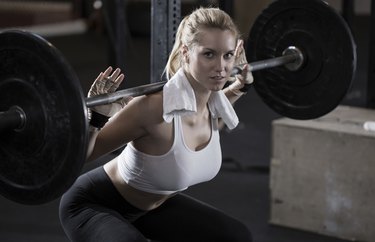
Having a weightlifting routine will help reduce any fears you might have of the weight room and make you a more confident woman in weightlifting and in life. The push/pull/leg split routine is a weightlifting routine that can be done by beginners or advanced female weightlifters. The routine is split among three days of the week with at least one day of rest between each lifting day. The routine allows for maximum recovery time, which eliminates the possibility of over-training or injuries, making it an ideal weightlifting option.
Routine
Video of the Day
On the first day of your workout routine, train your pushing upper-body muscles. On day two, train your leg muscles. On day three, train your pulling upper-body muscles. Abdominal muscles can be trained on any or all of the three training days, but should be completed at the end of your workout to avoid premature fatigue in your other muscle groups. Your shoulder muscles are used for both pushing and pulling and can be trained on either the push or pull day. Because chest exercises target the anterior deltoids, in order for your shoulders to have maximum recovery time, train them on push day, according to Aaaweight.com.
Video of the Day
Warm-up
Warming up before any exercise routine is critical for injury prevention and success in the weight room. Warm up aerobically for five to 10 minutes by either walking, jogging or use a cardio machine prior to beginning your lifting routine. After warming-up, your first weightlifting set should be a warm-up set. The warm-up set allows your muscles to prepare themselves for heavy lifting.
Push Day
Train chest, shoulders and triceps on push day. Examples of chest exercises include bench press, dumbbell chest press, pushups, cable crossover or machine chest press. Shoulder exercises include military press, lateral raises or bent-over lateral raises. Triceps exercises include overhead triceps extension, dumbbell kickbacks, dips or cable press down.
Leg Day
On leg day, focus on glutes, quadriceps, hamstrings and calves. Consider warming up a full 10 minutes before beginning this workout because of the large muscle groups involved. Begin your workout with a multiple-joint exercise such as squats, deadlifts or barbell lunges. These exercises target your entire lower body, so do them before moving onto single-joint exercises. Single-joint exercises include cable kickbacks, step-ups, leg extension, leg curl and standing calf raise.
Pull Day
Train your back, biceps and abdominal muscles on pull day. Back exercises include barbell shrugs, pullups, bent over rows or lat pull down, according to the website Exercises for Upper Back. Including at least one lower back exercise in your routine can help prevent low-back pain. Back extensions, good mornings and supermans are exercises that target the lower back. Biceps exercises include barbell curls, dumbbell curls, preacher curls or cable curls. Abdominal exercises include leg lifts, reverse crunches, bicycles or oblique twists.
Stretching
Complete each weightlifting workout by stretching the muscles trained that day. Stretching following your workout prevents injuries and reduces post-workout pain. When stretching, it is important to relax, go slow and never hold your breath or bounce. Focus on pain-free stretching, holding each stretch for at least 30 seconds.